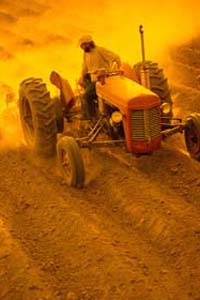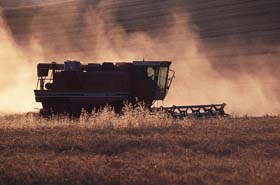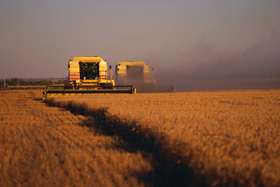Organic Dust
|
Do You Know... there are many hazards
associated with breathing organic dust in
agricultural operations? Organic dust comes from
hay, grain, fuel chips, straw, and livestock. Organic dust includes
molds, pollens, bacteria, pesticides, chemicals, feed and bedding particles, and
animal particles including hair, feathers, and droppings. Heavy concentrations of organic dust are
common in grain dryers, livestock
pens, and swine buildings or other enclosed spaces. Long-term exposure to
organic dust can lead to congestion, coughing or wheezing, sensitivity
to dust, and frequent infections, such as colds, bronchitis, and pneumonia. Over
time, exposure to organic dust can result in serious
respiratory illnesses, such
as
Organic Dust Toxic Syndrome (ODTS) and
Farmer's lung. Approximately one in 10 people working in agriculture will have an episode of ODTS, a temporary
flu-like illness. Repeated exposure can cause Farmer's Lung, an allergic disease caused
by mold spores which the body's immune system cannot counteract and may cause
lung damage and result in death.
|
|

|
The National Safety Council reported in 1990 that one-third of the 300
farm workers incapacitated due to respiratory conditions were caused by dust. |
|
| Teen Safety Solutions |
Employers have the primary responsibility for
protecting the safety and health of their workers. Employees are responsible for
following the safe work practices of their employers.
|
- Be aware of the health effects of
breathing toxic dust. If you are involved in any of
the following areas you may need respiratory protection against
organic dust:
- Working in dusty fields and buildings.
- Handling moldy hay.
- Working in or uncapping silos.
- Cleaning grain bins.
|
- Be aware that wearing a dust mask when working in dusty
conditions can help you avoid exposure to 'nuisance dust' but does not protect you against organic
vapors.
- Wear any provided personal protective
equipment (respirators - such as a NIOSH approved N95
air-purifying disposable particulate respirator), especially when working with grains or silage
(uncapping or unloading silos, chopping bedding, shoveling
grain, combining, or cleaning grain) in enclosed areas that may
contain toxic dust.
|

|
- Learn to recognize the symptoms for
ODTS
and when they can occur:
- Symptoms include cough, fever, chills, body aches and pains, shortness of breath, and fatigue.
- Symptoms occur 4 to 12 hours after exposure to high levels of organic dust and can last
up to seven days.
- Symptoms may occur after inhaling high levels of organic dust from moldy hay, silage, or grain.
- Know what to do if symptoms occur:
- Recognize early symptoms and seek medical help.
- Inform your doctor about recent dust exposures.
- Get training in the use and care of
respiratory equipment, including how to proper fit test the
equipment.
- Be healthy and maintain good diet, rest, and
exercise habits.
- Avoid exposure to cigarette smoke
in dusty environments.
|
|
|
Employer Safety Solutions |
Employers have the primary responsibility for
protecting the safety and health of their workers. Employees are responsible for
following the safe work practices of their employers.
- Develop a "safety first" attitude. Follow safe work practices all
the time and set a good example for others.
- Provide workers with respirators to
protect them from hazards associated with their
work. There are many types of
respirators and it is important to match the respirator to the job.
Be sure to select a respirator is
certified by NIOSH.
|
- Supply air-purifying respirators (APRs) in
toxic dust environments. The most commonly used respirator for farm
work is an APR that removes contaminants
from the air. Types of APRs include:
- APRs with particulate filter can be used to protect workers from dusts, mists, and fumes.
- APRs equipped with chemical cartridges can be used to protect workers
from gases and vapors, including pesticides.
- Gas masks can be used to protect workers from gases and vapors.
- Powered air purifiers can be used to protect workers from dusts, mists, fumes, and chemicals.
-
Have a professional fit-test your workers' respirators.
-
Train employees in proper use of respirators.
- Routinely clean and inspect all non-disposable
respirators. Discard disposable respirators when they
become dirty.
|

|
Respirators:
Upper right: 2-strap mask with exhalation valve. Lower right: Half face mask with replaceable cartridge. Left:
Powered air-purifying respirator. |
|
- Use automated equipment whenever possible to move decayed materials
that have high organic dust volumes.
- Take preventative measures to minimize contamination:
- Identify contaminants and hazards in the work environment and supply workers with the necessary protection.
- Limit worker exposure to contaminants by rotating workers through tasks where they are exposed to high levels of dust.
- Minimize exposure to dust by maintaining good ventilation in barns, silos, and other dusty areas before and during the work day.
- Ensure that workers wear respirators, masks, and other protective equipment and train them in the proper use,
fit, maintenance, and storage of the equipment.
- Use mold inhibitors.
- Bale hay, ensile crops, harvest, and store grain at recommended moisture content levels.
- Dry grain properly before storage
.
- Use dust-minimizing practices, such as dust binding, misting, and spraying.
|
- Follow these guidelines when working with moldy materials:
- Wet down feed before transferring to minimize dust.
- Convert to mechanical or automated feeding or feed-handling systems.
- Wet down the top of the silo before uncapping ensiled material.
- Use wetting techniques when cleaning out grain bins or other dusty areas
.
- Always have workers wear respiratory protection when handling moldy or dusty materials.
|

|
- Be aware and inform workers when dusts may contain higher
levels of mold spores such as:
- Late summer - while cleaning out grain bins before filling
with new grain.
- Early winter - opening new silos may release mold spores from
the top layer of silage.
|
|
|
Additional Information:
|
|

